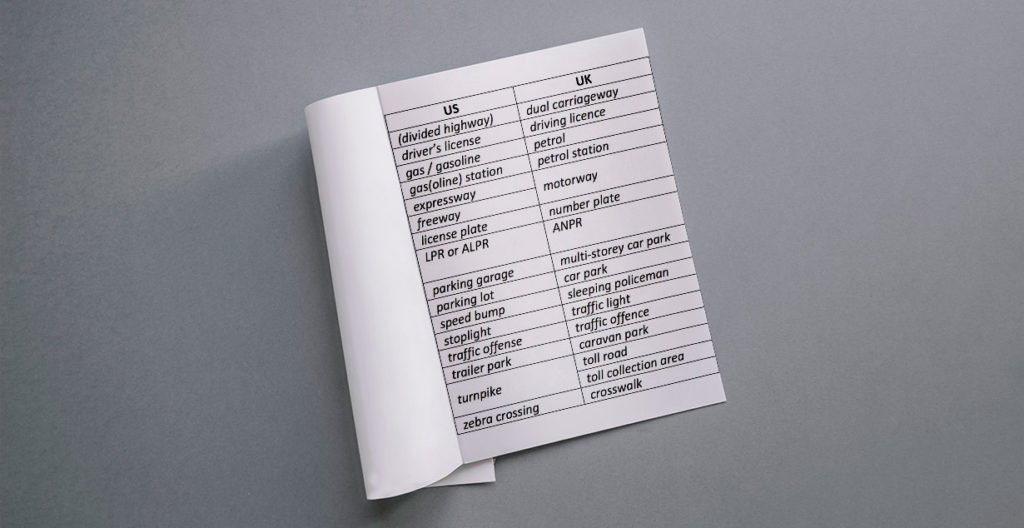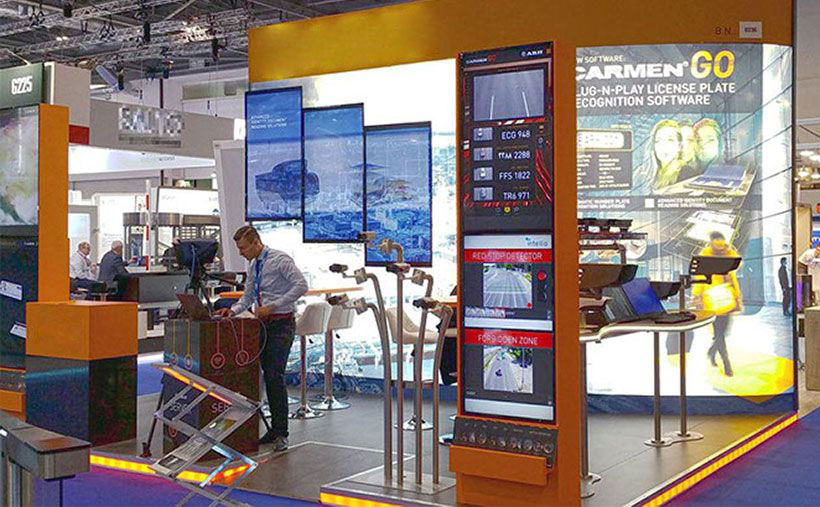US English – UK English – International English: Differences in Word Use and Spelling
Did you know that “number plates” are called “license plates” in American English? This is why when you approach a company with your automated license plate recognition (ANPR) solution, they most likely raise an eyebrow. But why is this distinction if both “number plate” and “license plate” mean the same?

In addition to the United Kingdom, many countries like South Africa, Australia, and India that used to be part of the British Empire use British English. Also, countries where English is taught at schools as a foreign language, tend to prefer the British variety. On the other hand, most English language media – ranging from TV series to music lyrics – means daily exposure to an American variety of English. Some vocabulary differences relevant to ANPR are shown in the chart below.

When you set the spellchecker while writing a document, you have to select the proofing language. There are multiple varieties of English on the list – from Australian English all the way to Zimbabwe English – as there are many spelling differences. See the table below for some US/UK orthographic differences.
| US | UK |
| -ense – as in license | -ence – as in licence |
| -er – as in kilometer | -re – as in kilometre |
| -ize – as in recognize | -ise – as in recognise |
| -og – as in analog | -ogue – as in analogue |
| -or – as in harbor | -our – as in harbour |
Table 2: Some spelling differences between American and British English
International English: British or American?
With differing standards and conventions, how do internet users and copywriters know which English to use? Style sheets advise writers: once you start using US spelling, stick to it. The same applies to UK spelling. It doesn’t look good on the printed page to see alternative spellings – like centre and center – within the same text. It makes a sloppy impression. Search engines, on the other hand, are said to automatically include spelling variations of any given search word – they even correct spelling mistakes.
The message to take home: when browsing the web, you can’t go wrong – as an author, it is best to be consistent.
Trade Show Culture, Social Sites, Magazines, Companies
Regional differences are blurred at international events like trade fairs, trade shows, and expos, functioning as the primary scenes of communication for stakeholders of the ANPR industry.

Discussion groups like ITS on LinkedIn create shared terminology serving as a common language for the industry. A company’s social media presence, for instance, Adaptive Recognition’s LinkedIn profile and updates, tells a lot about the company’s evolving technology and presence at international expos within the industry. Tech news published in magazines is also a communication channel. Although the publisher is headquartered in the UK, the magazine Intertraffic World, for instance, prefers ALPR to ANPR.
Conclusion
In summary, industry terminology evolves organically via exhibitions, online forums, and publications as well as channels of corporate communication.
As a way of closing this article, we suggest that you visit the previous articles in this series (Part 1 and Part 2) and test your knowledge of ANPR acronyms in the chart below.
| Acronym | Full name | Explanation for non-experts |
| AID | Automatic Incident Detection | Video analytics to identify traffic events |
| AVI | Automatic Vehicle Identification | Another name for ANPR |
| ALPR | Automatic License Plate Recognition Automated License Plate Recognition | Technology to read vehicle registration plates, called number plates in the UK and license plates in the US |
| ANPR | Automatic Number Plate Recognition Automated Number Plate Recognition | Technology to read vehicle registration plates, called number plates in the UK and license plates in the US |
| ANPR camera | Automatic Number Plate Recognition camera Automated Number Plate Recognition camera | Camera purpose-built for plate recognition, plate and image capturing |
| API | Application Programming Interface | Tools for building application software that makes it easier to develop a computer program by providing all the building blocks (see our article about ANPR API vs. ANPR SDK) |
| CCTV camera | Closed-Circuit Television Camera | Also known as video surveillance. Note that while CCTV cameras aren’t designed for ANPR, you can use Carmen® Box to add ANPR to any CCTV camera setup. |
| DVR | Digital Video Recorder | Currently, the expression describes computer applications – rather than standalone devices |
| ETC | Electronic Toll Collection | A system where fees for the use of the road (road pricing) are paid/received without using cash |
| FPS | Frame Per Second | How many video frames are recorded in a second |
| GPS | Global Positioning System | In ANPR, it usually comes up in the context of measurement point location identified by coordinates |
| GUI | Graphical User Interface | The menus, buttons, and icons where users can control the operation of a device or system |
| IP | International Protection Marking or Ingress Protection Marking | International standard to indicate waterproof and dustproof, e.g. IP67 rated camera |
| IP | Internet Protocol | See at ‘IP camera’ below |
| IP camera | Internet Protocol Camera | A camera that is remotely accessible via a computer network and the Internet. The term usually describes surveillance cameras or webcams, but many LPR cameras today are designed for web-based operation, as well. |
| IR | Infra-Red | In ANPR, this type of invisible light improves imaging without distracting drivers |
| ITS | Intelligent Transportation System Intelligent Transport System | A smart way of transport and traffic management for the safer and more coordinated use of transport networks |
| LPR | License Plate Recognition | Technology to read vehicle registration plates, called number plates in the UK and license plates in the US |
| LPR camera | License Plate Recognition camera | Camera purpose-built for plate recognition |
| OBE | On-Board Equipment | A device inside the vehicle to communicate with tolling systems: it is a way to identify the vehicle |
| OBU | Onboard Unit | A device inside the vehicle to communicate with tolling systems: it is a way to identify the vehicle |
| OCR | Optical Character Recognition | Computer technology to read physical letters and numbers and turn them into digital data |
| PoE | Power over Ethernet | A single cable to provide both data connection and electric power |
| RFID | Radio Frequency Identification | In the context of traffic management, it is a type of remotely accessible passive wireless chip to identify a vehicle |
| SDK | Software Development Kit | Tools that allow the creation of applications built on software (see Carmen® FreeFlow ANPR engine with SDK) |
| VMS | Variable Message Sign | Also called an electronic message sign, it displays textual messages for drivers like “Construction workers ahead” |
| VMS | Video Management System Video Management Software Video Management Server | It collects and stores video from cameras and other sources and makes them accessible for applications |
| VPR | Vehicle Plate Recognition | Technology to read vehicle registration plates, called number plates in the UK and license plates in the US |
| WIM | Weigh-In-Motion Weighing-In-Motion | Sensors built into the road surface to measure the axle weight of passing vehicles (see how our ANPR cameras help weigh-in-motion systems) |
Table 3: Abbreviations widely used in the ANPR industry
Any questions or inquiries? We’re here to support you every step of the way:


